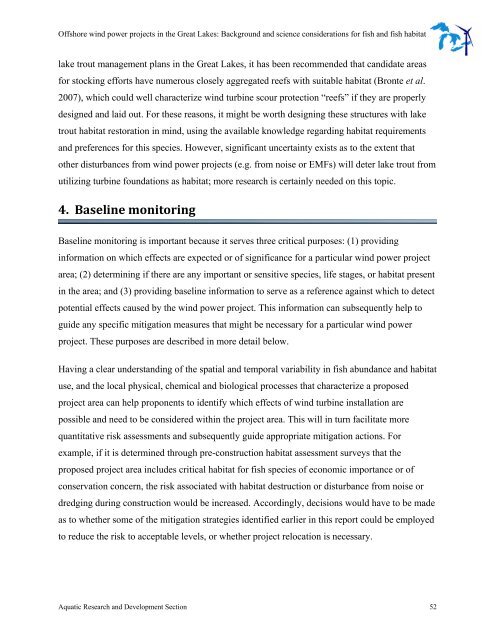Offshore Wind Power Projects in the Great Lakes - Ministry of ...
Offshore Wind Power Projects in the Great Lakes - Ministry of ...
Offshore Wind Power Projects in the Great Lakes - Ministry of ...
You also want an ePaper? Increase the reach of your titles
YUMPU automatically turns print PDFs into web optimized ePapers that Google loves.
<strong>Offshore</strong> w<strong>in</strong>d power projects <strong>in</strong> <strong>the</strong> <strong>Great</strong> <strong>Lakes</strong>: Background and science considerations for fish and fish habitat<br />
lake trout management plans <strong>in</strong> <strong>the</strong> <strong>Great</strong> <strong>Lakes</strong>, it has been recommended that candidate areas<br />
for stock<strong>in</strong>g efforts have numerous closely aggregated reefs with suitable habitat (Bronte et al.<br />
2007), which could well characterize w<strong>in</strong>d turb<strong>in</strong>e scour protection “reefs” if <strong>the</strong>y are properly<br />
designed and laid out. For <strong>the</strong>se reasons, it might be worth design<strong>in</strong>g <strong>the</strong>se structures with lake<br />
trout habitat restoration <strong>in</strong> m<strong>in</strong>d, us<strong>in</strong>g <strong>the</strong> available knowledge regard<strong>in</strong>g habitat requirements<br />
and preferences for this species. However, significant uncerta<strong>in</strong>ty exists as to <strong>the</strong> extent that<br />
o<strong>the</strong>r disturbances from w<strong>in</strong>d power projects (e.g. from noise or EMFs) will deter lake trout from<br />
utiliz<strong>in</strong>g turb<strong>in</strong>e foundations as habitat; more research is certa<strong>in</strong>ly needed on this topic.<br />
4. Basel<strong>in</strong>e monitor<strong>in</strong>g<br />
Basel<strong>in</strong>e monitor<strong>in</strong>g is important because it serves three critical purposes: (1) provid<strong>in</strong>g<br />
<strong>in</strong>formation on which effects are expected or <strong>of</strong> significance for a particular w<strong>in</strong>d power project<br />
area; (2) determ<strong>in</strong><strong>in</strong>g if <strong>the</strong>re are any important or sensitive species, life stages, or habitat present<br />
<strong>in</strong> <strong>the</strong> area; and (3) provid<strong>in</strong>g basel<strong>in</strong>e <strong>in</strong>formation to serve as a reference aga<strong>in</strong>st which to detect<br />
potential effects caused by <strong>the</strong> w<strong>in</strong>d power project. This <strong>in</strong>formation can subsequently help to<br />
guide any specific mitigation measures that might be necessary for a particular w<strong>in</strong>d power<br />
project. These purposes are described <strong>in</strong> more detail below.<br />
Hav<strong>in</strong>g a clear understand<strong>in</strong>g <strong>of</strong> <strong>the</strong> spatial and temporal variability <strong>in</strong> fish abundance and habitat<br />
use, and <strong>the</strong> local physical, chemical and biological processes that characterize a proposed<br />
project area can help proponents to identify which effects <strong>of</strong> w<strong>in</strong>d turb<strong>in</strong>e <strong>in</strong>stallation are<br />
possible and need to be considered with<strong>in</strong> <strong>the</strong> project area. This will <strong>in</strong> turn facilitate more<br />
quantitative risk assessments and subsequently guide appropriate mitigation actions. For<br />
example, if it is determ<strong>in</strong>ed through pre-construction habitat assessment surveys that <strong>the</strong><br />
proposed project area <strong>in</strong>cludes critical habitat for fish species <strong>of</strong> economic importance or <strong>of</strong><br />
conservation concern, <strong>the</strong> risk associated with habitat destruction or disturbance from noise or<br />
dredg<strong>in</strong>g dur<strong>in</strong>g construction would be <strong>in</strong>creased. Accord<strong>in</strong>gly, decisions would have to be made<br />
as to whe<strong>the</strong>r some <strong>of</strong> <strong>the</strong> mitigation strategies identified earlier <strong>in</strong> this report could be employed<br />
to reduce <strong>the</strong> risk to acceptable levels, or whe<strong>the</strong>r project relocation is necessary.<br />
Aquatic Research and Development Section 52
















